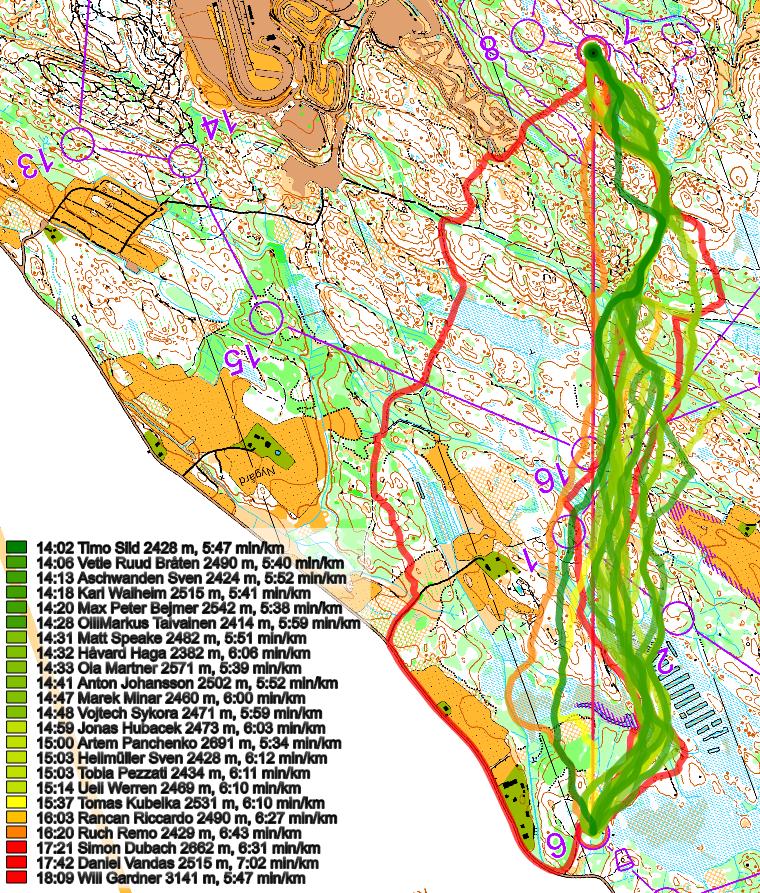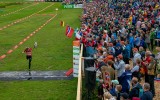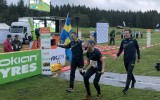In WOC2019's GPS Analysis Column World of O's Jan Kocbach takes a look at the GPS-tracking from selected races or trainings in WOC 2019 relevant terrain. In this first edition of the column focus is on the Euromeeting Long distance organized at Rudskogen September 3rd 2017.
The main takeaway-point from the Euromeeting Long distance (see full GPS-tracking men / women) was that on this particular course you did not lose much time when keeping close to the line. One interesting observation pointing in that direction is that the men's winner, Timo Sild, was also the man who ran shortest of the men with GPS trackers. Sild ran 14.7 km on the 13.6 km long course. Also, both on the men's and the women's course the fastest route was never more than 75 meter away from the direct line, except for one leg on each course: Leg 6 to 7 in the men's course and leg 12 to 13 in the women's course. We take a closer look at these two legs below.
Men's leg 6 to 7

This was the longest leg on the course - 2.2 km long. Following the line from control 6 to 7, it is evident that the first 80% of the leg is mostly flat, and then there is more hilly terrain in dense forest when approaching the control, including a climb of around 25 meter. There is a forbidden area in a marsh under the line shortly after control 6, but except for this there is not much to really slow you down directly under the line until you reach the 25 meter climb. If not for the forbidden area/marsh, going 100% straight until the climb would probably have been one of the very best alternatives.
With the forbidden area in place, the fastest athletes spread to the left and right on the first 80% of the leg, but still keeping very close to the line. Sild with the fastest route runs first to the left and then crosses the line halfways to the control. All the fastest routes choose to not take the 25 meter climb into dense vegetation - instead running around the hill to the right on the path. This both saves some climb, and makes the control taking easier.
 '
'
Taking a look at Sild's route on the last part of the leg (see below), you see how Sild finds a good route into the control.

Women's leg 12 to 13

On the women's course it was also mostly about running straight - which is quite uncommon in the women's class on a long distance. The only leg where running around was faster was the leg to control 13. This was a quite short leg (600 meters long) with the option to either run straight through terrain with variable runnability with careful orienteering - or to run around to the left on road/path with the possibility to simplify the control taking.
Surprisingly for such a short leg the fastest route was run all the way around to the left, running nearly 50% longer than the straight line (Ellinor Tjernlund, 5:17). The more straightforward control taking is part of the story, and so is the fact that you make the orienteering for most of the leg really easy when running around to the left. Several of the runners running direct did mistakes and lost significant time here.

It is also interesting to see how the men solved the same leg (for them this leg was control 18 to 19). Here the fastest times were run straight - with Anton Johansson losing a minute as the fastest running around to the left. This confirms the usual observation that the women can run further around than the men without losing time - however not how many men do significant mistakes when running straight here.

Summary
The Euromeeting long course and terrain was mostly about running straight and finding good micro-routechoices. This was partly due to the terrain and partly due to the course: When O-Festivalen long distance was organized in the same terrain last year there were several legs were straight was not the fastest. There is also more WOC 2019 relevant terrain which is more about routechoices and less about pure compass running - stay tuned to learn more about that in the next edtions of the GPS Analysis Column.


